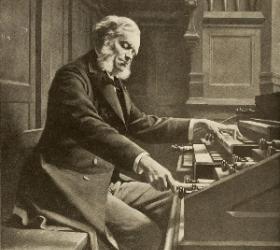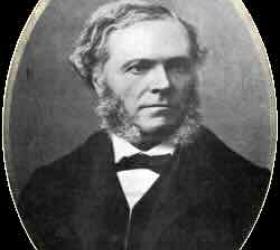
While quite substantial in quantity, Bulgarian music for organ has been largely unknown, due mainly to lack of access. It had not been published until recently, when a new series, Organ Music by Bulgarian Composers, became available. Thus, music previously known to only a few organists is now ready to enrich the repertories of organists worldwide. This music consists of contemporary works only because Bulgarian organ traditions are quite young, and because the country has only a handful of instruments.1
The Union of Bulgarian Composers released the first volume in March 2009. It consists of four works: Victimae Paschali Laudes by Neva Krysteva; Triptych by Sabin Levi (who is also the series’ music editor); Fantasia by Velislav Zaimov; and Four Spiritual Chants on Themes by Nerses Shnorhali (1101–1173) by Artin Poturlian. Also discussed in this article is Krassimir Kiurkchiysky’s Aria, presently not included in the series, but available from the Union of Bulgarian Composers.
The second volume, released in May, included: Stefan Ikonomov’s Prelude, Choral and Fuga; Mystical Evening by Atanas Atanasov (for mezzo-soprano and organ); Modulations by Simo Lazarov (for organ and tape); and Evgeny Cheshmedjiev’s Two Frescoes. The third volume is currently in progress, and, hopefully, there will be more to come.
Although not included in the series, Krassimir Kiurkchiysky’s Aria is worth mentioning. Kiurkchiysky belongs to the older, “national school” generation, specializing in a style based mainly on Bulgarian folklore. Written in a traditional harmonic language, this piece is a real 20th-century intabulation with a later composed contrasting section that appears at the beginning and the end. The original musical piece written for choir is an arrangement of the Bulgarian folk song Kalimanku. The song appears for the first time in the sixth measure (right hand uppermost voice) representing the middle of the piece. (Example 1)
From the sixth measure on, the music is almost exactly the same as in the choir version. The complex ornaments, characteristic of the vocal folklore of the Bulgarian Rodopi mountains, are simplified in this variant for organ. The song is repeated again until the reappearance of the beginning section.
With some sonata elements present, Velislav Zaimov’s Fantasia is an example of a piece written on a large scale, characteristic of this composer’s numerous symphonic works. After the opening motive, appearing many times through the piece, there is a Shostakovich-like rhythmic-motivic development, then we arrive at the first soggetto cavato section. The name “S. (Stefan) Dalchev2” is musically spelled [e]S, D, A[l], C, E, F, using the German note-spelling system, where Es is E-flat. The Latin letters appear in the original hand-written manuscript. (Examples 2 and 3)
The composer develops further the primary music material, arriving at the fortissimo section in the middle, where the speed is “increased” artificially, using smaller and smaller rhythmic values—starting with eighth-note pulsation and through triads arriving at sixteenth-note motion, where the name subject “S. Dalcef” appears again in a long pedal cantus firmus.
Having passed the climax, the motion slows down—through eighths and quarters we arrive at a half-note/whole-note section, meditative and sorrowful, followed by the piece’s ending. The Bulgarian organist’s name appears two more times in the music texture, and the last time each letter is stated in a different voice. Tritones are favored musical material, more in the vertical. The music is tragic and chromatic, while having some tonal reference points.
Artin Poturlian, a Bulgarian Armenian composer, explores the songs of the Medieval Armenian composer Nerses Shnorhali, in his Four Spiritual Chants on themes by Nerses Shnorhali (1101–1173). Organ is often used in the Armenian liturgy; there is an organ in Etchmiadzin, the seat of the Armenian church, and in many other locations in Armenia, including the Music Academy in Yerevan. Nerses Shnorhali was a famous poet and composer, Catholicos (head bishop) of the Armenian church, theologian and writer.3
While using diatonic music language, in accordance with the songs, Poturlian does not employ traditional harmony, relying instead on pandiatonicism. All pieces are strictly linear, involving the original chants’ intricate rhythmic signature into complex complementary structures. (Example 4) This technique is used mainly in the first and last pieces.
In this cycle, there are plenty of “old style” compositional techniques: hocketing (in the second piece), cantus firmus-like choral elements, straight and time-shifted canons, and complex ornaments in the spirit of florid organum. Keeping the songs’ vocal characteristics alive, the composer often uses quasi-vocal fiorituras, in rubato. (Example 5) Also present are augmentations, diminutions, even elements of ostinato, derived from the imitational treatment of the songs’ phrases.
Neva Krysteva, the “matriarch” of the Bulgarian organ school, is represented in this volume with her Victimae Paschali Laudes, based on the Gregorian chant. It is given in a free, improvisatory fashion, with plenty of motivic figuration, derived from the chant. Ostinati are important part of this fantasy, with shifting accent figurations. There are also chant citations with added “mistaken” fictas, and growing motives, repeating with more and more added notes. One can see percussion instruments’ stylization, in the manuals and pedal alike, written out clusters and vibrati. (Example 6) This virtuosic piece is written with extensive knowledge about the organ, and is often performed by its author.
Sabin Levi uses sonoric effects in the first part of his Triptych (Reflecting Pool), together with some symmetry. Utilizing different manuals, the two hands play in the same region of the keyboard, while in the middle of the piece there is a symmetry between the six voices: 1:6, 2:5, 3:4. (Example 7) The second part of the cycle (Come!) is contemplative, with figurations reminiscent of bird chant, while in the third, called Echo, there are parallelisms in the voices. For example, this appears between the uppermost voices of each hand, followed by echo effects between the manuals. (Example 8) While not tonal by definition, this piece has a noticeable tonal hierarchy of sorts, perhaps distantly related to quartal harmony.
In the second volume, Stefan Ikonomov’s Prelude, Choral and Fuga is an impressive achievement, written with a good idiomatic knowledge of the organ and its possibilities. Ikonomov’s traditional tonal language has some interesting additional coloristic features: cross relations, ellipsis, elements of modality. The serene Choral captures the listener with its calm, dignified cantus firmus. (Example 9) The development of the chromatic Fuga theme, with its fixed countersubject, is somehow reminiscent of Reger. This piece is dedicated to Stefan Dalchev.
Evgeny Cheshmedjiev’s Two Frescoes demonstrate this composer’s intellectually novel approach toward form building. The motive in the soprano in measures 4–5, 9–10, 15–17 etc., is basically the same; harmonization is subtly different. The motive appears again and again, being the spinal column of both pieces. (Example 10) The two pieces appear to be quite different, yet their complex, tonal melodic-harmonic language is shared, as is most of the thematic material. There are some pedal designations suggested in the manuscript; the editor also provides some additional, alternative pedal realizations. Those two miniatures have a somewhat minimalistic, laconic quality about them.
The last two pieces in the second volume employ voice and tape in addition to the organ. Atanas Atanasov’s Mystical Evening, for mezzo-soprano and organ, employs a poem by well-known Bulgarian poet Atanas Dalchev, related to the organist Stefan Dalchev. The text of the poem (translated, but not rhythmicized) reads as follows:
From [the] grayish chapels of the twilight,
the bell of sun keeps tolling
and men’s and women’s shadows,
set out to the sundown, are now crawling.
Repentant, full of grief and sorrow,
with heart bloomed in meekness
and hands being crossed by weakness
I seem to be the last one, who will follow.
My soul, remorseful, praying deeper,
and passionate devotions burn the lips,
the lips of a ragged and haggard worshipper
who walks the path of evening mist.
But in the grayish chapels of the twilight
lost men and women come with fuss
and fallen down the grayish wall
they bow and cry, and cross.
And I’m advancing, full of tears and sorrow,
I see the black door swinging shut,
my way through the gate of night is cut.
And I am now alone in darkness,
alone, not knowing what will follow.
The vocal part is set to both Bulgarian and English versions of the poem. The musical language has some tonal elements and quasi-Bartókian intervallic orientation, while maintaining a more conventional metric-rhythmic scheme. (Example 11)
A Bartókian intervallic movement, together with some ever-present syncopation is also the trend in Simo Lazarov’s Modulations for Organ and Waves, actually written for organ and tape (CD). This 15-minute piece uses the tape in its first and third movements; the middle one, Scherzo, is performed solo (all are performed segue). Here, traditional harmonic functions are not present, while the composer’s attention seems to be more oriented towards sound mass. At times, the organ part thins out to a single line; other times massive chordal structures are present. (Example 12) In two cases there are quite long tacet sections in the organ part, and the tape is left solo. The CD is included in the second volume.
Almost all pieces in the two volumes have been performed in concert in various locations in Europe, and some of them are also commercially released as recordings. The publication of these pieces represents a rich addition to the repertoire of organ music and a welcome access to the exciting contemporary organ works of Bulgarian composers.




